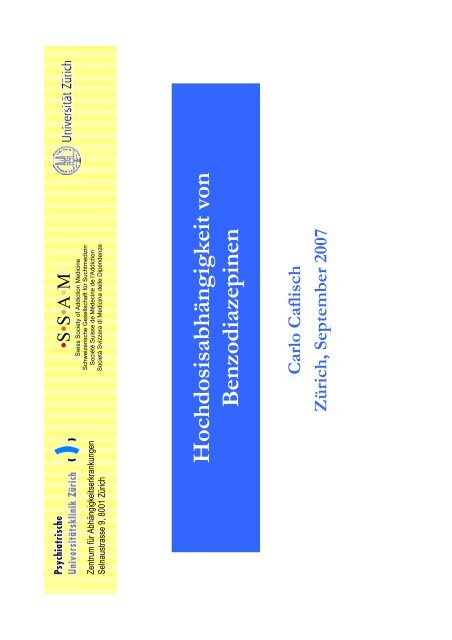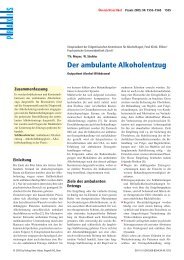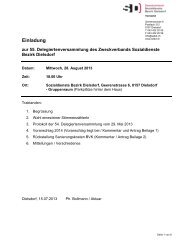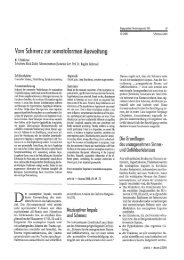Referat Dr. med. C. Caflisch
Referat Dr. med. C. Caflisch
Referat Dr. med. C. Caflisch
You also want an ePaper? Increase the reach of your titles
YUMPU automatically turns print PDFs into web optimized ePapers that Google loves.
Zentrum für AbhängigkeitserkrankungenSelnaustrasse 9, 8001 Zürich•S•S•A•M•Swiss Society of Addiction MedicineSchweizerische Gesellschaft für Sucht<strong>med</strong>izinSociété Suisse de Médecine de l'AddictionSocietà Svizzera di Medicina delle DipendenzeHochdosisabhängigkeit vonBenzodiazepinenCarlo <strong>Caflisch</strong>Zürich, September 2007
ZENTRUM FÜR ABHÄNGIGKEITSERKRANKUNGENDER PSYCHIATRISCHEN UNIVERSITÄTSKLINIK ZÜRICHSelnaustrasse 9, 8001 ZürichTelefon: 044 205 58 00 Fax: 044 205 58 02Ambulanter BereichAbklärung und Behandlung von Patienten mit Störungen durchpsychotrope SubstanzenSpezialsprechstunden für: Alkohol / Störungen durch Kokain /Cannabis und „moderne“ <strong>Dr</strong>ogenTagesklinikzur <strong>med</strong>izinischen, sozialen und beruflichen Reintegration<strong>Dr</strong>ogen-NotfalldienstErreichbar über das Ärztefon 044 321 21 21 (01 269 69 69)Mo-Fr: 18.30-08.00 Sa/So: 24hForschungsgruppe
Geschichte der PsychopharmakaMorphin 1804Kokain 1860Barbital 1902 VERONALChlorpromazin 1953 LARGACTILImipramin 1957 TOFRANILChlordiazepoxid 1960 LIBRIUM
1953-1965Die Lancierung der Benzodiazepine1957 Entdeckung der Benzodiazepin-GruppeMitte der fünfziger Jahre wird eine neue Gruppe vonBeruhigungsmitteln (Tranquilizer) in die Therapie eingeführt.Leo Sternbach greift auf eine Substanzklasse zurück, die erbereits früher bearbeitet hat, und stösst dabei auf die Gruppeder Benzodiazepine. Eines davon, Ro-5-0690, wird später unterdem Namen Librium eingeführt werden.
Librium wird als erstes Medikament der neuen Substanzklasseder Benzodiazepine zur Behandlung emotioneller,psychosomatischer und muskulärer Störungen eingeführt.Librium erlebt einen spektakulären Markterfolg und eröffnet einweites internationales Forschungsfeld bei Roche.Modifikationen an der Basisstruktur der Benzodiazepine führenzu einer Reihe von Produkten: Librax (1961), Valium Roche(1963) Mogadon (1965), Limbitrol (1967), Nobrium (1968),Dalmadorm (1972), Rivotril (1973), Lexotanil (1974), Rohypnol(1975) und Dormicum (1982).
Leavitt et al. 2000When „Enough“ Is Not Enough: New Perspectives onOptimal Benzodiazepine (BZD) Maintenance DoseGewisse Programme verschreiben ungenügende tägliche BZDDosen. Die Patienten klagen über Entzugssymptome und siehören nicht auf, illegal erworbene BZD dazu zu konsumieren.Trotzdem sind Praktiker kaum gewillt die BZD-Tagesdosenüber eine gewisse mehr oder weniger willkürliche Grenze zuerhöhen.Serumspiegel helfen kaum weiter.Indikatoren für eine ungenügende Substitution sind:Entzugssymptome und fortgesetzter Konsum von zusätzlichennicht verordneten BZD.
Leavitt et al. 2000When „Enough“ Is Not Enough: New Perspectives onOptimal Methadone Maintenance DoseThe Mount Sinai Journal of Medicine Vol. 67Some methadone maintenance treatment (MMT) programsprescribe inadequate daily methadon doses. Patient complain ofwithdrawal symptoms and continue illicit opioid use, yetpractitioners are reluctant to increase doses above certainarbitrary thresholds.New research suggests that doses ranging from 120mg/d tomore than 700mg/d, with correspondingly higher serummethadone levels, may be optimal for many patients.
Herr R. M. , *1968when „enough“ is not enoughAprilDi 03. 40 Tbl. Seresta forte à 50mgAprilMi 18. 40 Tbl. Seresta forte à 50mgMi 04. 80 Tbl. Seresta forte à 50mgSa 07. 80 Tbl. Seresta forte à 50mg60 Tbl. Dormicum à 15mg60 Tbl. Rohypnol à 1mgFr 13. 80 Tbl. Seresta forte à 50mg60 Tbl. Dormicum à 15mg60 Tbl. Rohypnol à 1mgFr 20. 80 Tbl. Seresta forte à 50mg60 Tbl. Dormicum à 15mg60 Tbl. Rohypnol à 1mgFr 27. 80 Tbl. Seresta forte à 50mg60 Tbl. Dormicum à 15mg60 Tbl. Rohypnol à 1mgEntspricht fast 500mg Diazepam tgl.
The purpose of the study was to assess prevalence of benzodiazepine use in theSwiss adult population and to assess on benzodiazepine prescription patterns ofphysicians in domiciliary practice.Study design A retrospective, population-based cross-sectional study with520 000 patients covering a 6-month period.Methods We estimated the prevalence, amount and duration of benzodiazepineuse using a pharmacy dispensing database.
Results Of all patients, 9.1% (n= 45 309) received at least one benzodiazepineprescription in the 6-month period. Most persons receiving benzodiazepineprescriptions were women (67%), and half of all patients were aged 65 or older. Of45 309 patients with benzodiazepine prescriptions, 44% (n =19 954) had one singleprescription, mostly for a short period ( 90 days), and in lower than therecommended or within the recommended dose range.In patients with long-term use (n= 25 354), however, 1.6% (406) had benzodiazepineprescriptions in extremely high doses. The sample of patients with repeatedprescriptions allowed an estimation of a benzodiazepine use of 43.3 daily defineddoses per 1000 inhabitants in Switzerland.Conclusions Benzodiazepine prescriptions were appropriate for most patients andthus were prescribed in therapeutic doses, as indicated in the treatment guidelines.On the other hand, our survey showed that 1.6% of the patients had prescriptions forlong time periods at very high doses, indicating an abuse or dependence onbenzodiazepines in this subgroup.Int Clin Psychopharmacol 22:292–298 c 2007 Lippincott Williams & Wilkins.
<strong>Dr</strong>ug Alcohol Depend. 1993 May;32(3):257-66.Benzodiazepine and sedative use/abuse by methadone maintenanceclients.Iguchi MY, Handelsman L, Bickel WK, Griffiths RR.Hahnemann University School of Medicine, Department of Mental HealthSciences, Philadelphia, PA 19102-1192.Clients at three geographically separate methadone maintenance clinics weresurveyed regarding their lifetime use of ten commonly used benzodiazepinesand barbiturates. In Baltimore (n = 50), 94% reported use of one or more ofthese drugs in their lifetime, with 66% reporting use in the last 6 months. InPhiladelphia (n = 218), 78% reported use in their lifetime, with 53%reporting use in the last 6 months. In New York City (The Bronx) (n = 279),86% reported use in their lifetime, with 44% reporting use in the last 6months. Subjects reporting a history of use of at least 7 of 10 of the na<strong>med</strong>sedatives were recruited for a more detailed interview. They reported that,among the benzodiazepines, diazepam, lorazepam, and alprazolam werefrequently used for their 'high' producing effects, and for selling to produceincome. In contrast, chlordiazepoxide, oxazepam, and phenobarbital, hadmuch lower ratings of 'high' and were much less likely to be obtained forgetting 'high' or for resale.
AWMF onlineArbeitsgemeinschaft derWissenschaftlichenMedizinischenFachgesellschaftenLeitlinien der Dt. Ges. f. Suchtforschung und Suchttherapie (DG-Sucht)und der Dt. Ges. f. Psychiatrie, Psychotherapie und Nervenheilkunde (DGPPN)AWMF-Leitlinien-RegisterNr. 076/009Entwicklungsstufe:Medikamentenabhängigkeit(Sedativa-Hypnotika, Analgetika, Psychostimulantien)2
Eine Abhängigkeit von Benzodiazepinen (BZD) intherapeutischer Dosierung wird bei Langzeitanwendungohne Behandlungsunterbrechung häufig nicht manifestund nicht als problematisch erlebt.Bei Vorliegen eines Entzugswunsches sollteausschleichend über 4-10 Wochen herabdosiert werden,schlagartiges Absetzen ist zu vermeiden.Kurzwirksame BZD und die "3 Z" sollten auf eineÄquivalenzdosis eines Standard-BZD (z.B. Diazepam,Dikaliumchlorazepat) umgestellt werden.
Bei langwirksamen BZD kann mit der Substanz selbstoder einer Standardsubstanz entzogen werden.Eine psychologische Unterstützung derEntzugsbehandlung ist durchzuführen, auch kann dieVerwendung anderer Psychopharmaka notwendigwerden.Bei Misslingen des ambulanten Entzuges, beiHochdosisabhängigkeit von BZD oder beiAbhängigkeit von Clomethiazol ist ein stationärerEntzug angeraten.
Index · Contents · Introduction · Chapter I · Chapter II · Withdrawal Schedules · Chapter IIIMedical Disclaimer · Order A Printed Copy · Professor Ashton's Main PageThe Ashton Manual in other languagesASHTON MANUAL INDEX PAGEBENZODIAZEPINES: HOW THEY WORKAND HOW TO WITHDRAW(aka The Ashton Manual)• PROTOCOL FOR THE TREATMENT OF BENZODIAZEPINE WITHDRAWAL• Medical research information from a benzodiazepine withdrawal clinicProfessor C Heather Ashton DM, FRCPRevised August 2002• Ashton Manual Index Page• Contents Page• Introduction• Chapter I: The benzodiazepines: what they do in the body• Chapter II: How to withdraw from benzodiazepines after long-term use• Chapter II: Slow withdrawal schedules• Chapter III: Benzodiazepine withdrawal symptoms, acute & protracted
Schedule 10. Withdrawal from oxazepam (Serax) 20mg three times daily (60mg) with diazepam(Valium) substitution (20mg oxazepam is approximately equivalent to 10mg diazepam)MorningMiddayEvening/NightDaily DiazepamEquivalentStarting dosage oxazepam 20mg oxazepam 20mg oxazepam 20mg30mgStage 1(1 week)oxazepam 20mgoxazepam 20mgoxazepam 10mgdiazepam 5mg30mgStage 2(1 week)oxazepam 10mgdiazepam 5mgoxazepam 20mgoxazepam 10mgdiazepam 5mg30mgStage 3(1 week)oxazepam 10mgdiazepam 5mgoxazepam 10mgdiazepam 5mgoxazepam 10mgdiazepam 5mg30mgStage 4(1-2 weeks)oxazepam 10mgdiazepam 5mgoxazepam 10mgdiazepam 5mgStop oxazepamdiazepam 8mg28mgStage 5(1-2 weeks)Stop oxazepamdiazepam 8mgoxazepam 10mgdiazepam 5mgdiazepam 8mg26mgStage 6(1-2 weeks)diazepam 8mgStop oxazepamdiazepam 8mgdiazepam 8mg24mgStage 7(1-2 weeks)diazepam 10mgdiazepam 2mgdiazepam 10mg22mgStage 8(1-2 weeks)diazepam 10mgStop diazepamdiazepam 10mg20mgStage 9(1-2 weeks)diazepam 8mg--diazepam 10mg18mgContinue as on Schedule 2 from Stage 12Schedule 10 Notes:1.Oxazepam is short-acting (half-life 4-15 hrs) so substitution to diazepam (long-acting) is recommended.2.Diazepam need only be taken twice a day.3.A change from 5mg to 2mg diazepam tablets is necessary from Stage 4 onwards.
Authors’ conclusionsAll included studies showed that gradual taper was preferable toabrupt discontinuation. The results of this systematic reviewpoint to the potential value of carbamazepine as an effectiveintervention for benzodiazepine gradual taper discontinuation.But, larger controlled studies are needed to confirmcarbamazepine’s potential benefit, to assess adverse effects andto identify when its clinical use might be most indicated. Othertreatment approaches to benzodiazepine discontinuationmanagement should be explored (antidepressants,benzodiazepine receptors modulator).
AbstractBackground: Opioid maintained patients report high levels of anxiety, but the use ofbenzodiazepines among these patients has been associated with negative outcomessuch as increased risk of overdose and death and poorer retention in programmes.Previous research has used interview or urine analysis to assess benzodiazepine use.In this study a prescription database was applied.Methods: The Norwegian Prescription Database covers all prescriptions for the entirepopulation from 1 January 2004. Benzodiazepine prescriptions to patients receivingmethadone (N= 1364) or buprenorphine (N= 805) in 2004 and 2005 were studied.Type and amount of drugs received were investigated.Results: Overall 40% of the patients received at least one prescription for abenzodiazepine drug. Oxazepam was the most frequently prescribed drug. Femalepatients, methadone-maintained patients and patients in the liberal programmesreceived a prescription more often. Prescribed doses were high and highest in theliberal programmes. Older patients received more hypnotics. Dose of maintenancedrug was positively related to amount of anxiolytics prescribed.Conclusions: This study showed that more benzodiazepines were prescribed to opioidmaintenance treatment patients than previously shown by investigations usinginterview or urine analysis. The doses prescribed were generally high. In light of thenegative outcomes following benzodiazepine use in these patients, Norwegiandoctors need to review their prescription practices.
Australian and New Zealand Journal of Psychiatry 2003; 37:458–463Treatment of benzodiazepine dependence inmethadone maintenance treatment patients:a comparison of two therapeutic modalitiesand the role of psychiatric comorbidityTal Weizman, Marc Gelkopf, Yuval Mela<strong>med</strong>, Miriam Adelson, Avraham Bleich
EINLEITUNGBenzodiazepinabhängigkeit bei Patienten, die mitMethadon substituiert werden, ist weltweit endemisch.Gute Leitlinien, wie mit diesem Problem umgegangenwerden soll, existieren nicht.Ziel dieser naturalistischen Studie von Weizman et al.war es, eine BZD-Entzugsbehandlung mit einer BZD-Substitutionsbehandlung zu verglichen.
METHODE (1)Benzodiazepinabhängige Patienten in einemMethadonprogramm in Tel Aviv.Ausreichende Methadondosen (keine gesetzlichenoberen Limiten).Interdisziplinäres Behandlungsteam.Tägliche Abgabe der Benzodiazepine.
METHODE (2)Von insgesamt 80 Patienten, bei denen eine langjährigeAbhängigkeit auf hohe Dosen von BZD diagnostiziert wordenwar und die schon mehrmals versucht hatten abstinent zuwerden, konnten im Verlauf von 3 Jahren 66 Patienten für dieStudie rekrutiert werden.Alle erhielten die ersten 2 Wochen 6 mg Clonazepam pro Tag.Bei der Entzugsgruppe (n=33) wurde das Clonazepam über ca.6 Wochen ausgeschlichen.Bei der Gruppe der Substituierten (n=33) wurde versucht eineErhaltungsdosis mit möglichst wenig Craving und Sedationeinzustellen.
RESULTATE (1)Alle Patienten bis auf einer (65/66) missbrauchtenhauptsächlich Flunitrazepam, zusätzlich wurde Diazepam(42/66), Alprazolam (9/66) und Nitrazepam (7/66) konsumiert.Die mittlere Erhaltungsdosis in der Gruppe der Substituiertenwar 2,64 mg Clonazepam (SD=1,46 mg, range 0.5-6 mg).Erhaltungsdosis 1-2 mg, n=16Erhaltungsdosis 3-4 mg, n=15Erhaltungsdosis 5-6 mg, n=2
RESULTATE (2)Nach 12 Monaten Erfolg MisserfolgEntzug mit Clonazepam 4 25Substitution mit Clonazepm 17 9p < 0.001
DISKUSSION (1)Die Substitution mit Clonazepam ist eine guteTherapieoption für BZD-abhängige Methadonpatientenmit einer langen Anamnese von BZD-Abusus und misslungenen Entzugsversuchen.Für die Subgruppe von Behandlungsversagern, die vorBehandlungsbeginn besonders hohe BZD-Tagesdosenkonsumierten, war die Clonazepamdosismöglicherweise zu tief.
DISKUSSION (2)Patienten mit einer Achse-I-Störung profitierten mehrvon der Behandlung mit Clonazepam als Patienten miteiner dissozialen Persönlichkeitsstörung.Limiten der Studie: Die Resultate basieren auf denAngaben der Patienten und dem klinischen Eindruckder Behandler. Es ist keine doppelblinde PlacebokontrollierteStudie.
Der „Seresta-Notstand“Sommer 2007 Seresta forte nicht mehr lieferbar…Procedere?
Handelsname (CH)WirkstoffDosierungMax. TagesdosisKompendiumT maxHalbwertszeitAequivalenzdosenzu Valium 10mgGassenpreisDORMICUM Midazolam 7,5-15mg 30mg 1h 1,5-2,5h 7,5mg 5.-STILNOX Zolpidem 10mg 10mg 0,5-3h 3h 20mgROHYPNOL Flunitrazepam 0,5-1mg 2mg 0,75-2h 10-16h 1mg 5.-XANAX Alprazolam 0,5-4mg 6mg 1-2h 12-15h 1mgIMOVANE Zopiclon 7,5mg 7,5mg 1,5-2h 5-6h 15mgTEMESTA Lorazepam 1-6mg 7,5mg 1-2,5h 12-16h 2mgLEXOTANIL Bromazepam 1,5-9mg 36mg 1-2h 15-28h 6mgSERESTA Oxazepam 15-100mg 150mg 2-3h 7-11h 25mg 5.-VALIUM Diazepam 5-20mg 200mg 0,5-1,5h 24-80h 10mg 5.-TRANXILIUM Clorazepat 5-60mg 200mg 1-1,5h 25-60h 15mgURBANYL Clobazam 15-60mg 120mg 1,5-2h 20-50h 20mgDEMETRIN Prazepam 10-30mg 30mg 1-2h 50-80h 20mgSOLATRAN Ketazolam 15-60mg 60mg 3h 2(52)h 30mgRIVOTRIL Clonazepam 1-4mg 20mg 2-4h 20-60h 1mgXANAX ret Alprazolam 0,5-4mg 6mg 5-11h 12-15h 1mg
Der „Seresta-Notstand“Sommer 2007 Seresta forte nicht mehr lieferbar…Umstellung in zwei Schritten.1. „Valium unterdosiert“ 10mg Valium für 50mg Seresta2. „Rivotril richtig dosiert“ 2mg für 10mg Valium
LEITLINIENSubstitution von BZD?• Diagnose der Hochdosisabhängigkeit von BZD versus anxiolytischeBehandlung mit hohen Dosen von Benzodiazepinen…• Für Patienten, die einen Entzug machen wollen: Umstellung zumBeispiel auf Clonazepam und dann langsamer Abbau…• Für Patienten, die keinen Entzug wollen, Substitution mit zum BeispielClonazepam erwägen.• Keine Substitution mit DORMICUM, ROHYPNOL oder SERESTA
SCHLUSSBEMERKUNGENStudien zur Substitution wären angesagt?Ist Clonazepam, Diazepam, Ketazolam oder Clobazam dasbeste Substitutionsmittel?Was sagt der Kantonsarzte dazu?Was sagt die Krankenkasse dazu?
ENDE












